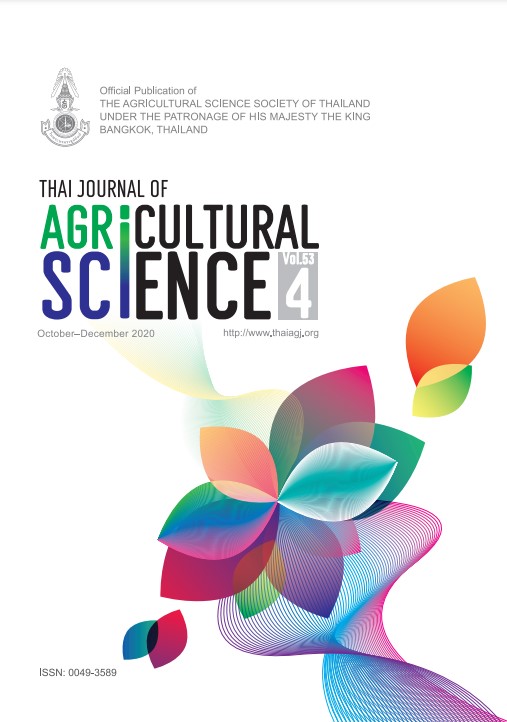Sequence–related amplified polymorphism (SRAP) molecular marker: DNA fingerprinting studying on economic and agricultural earthworms in North of Thailand
Main Article Content
Abstract
The terrestrial earthworms in agricultural areas were collected in Chiang Mai and Lamphun province from May to the middle of June. They could be divided into two major families (family Megascolecidae and family Glossoscolecidae) by morphology. Moreover, the economic species which are Perionyx excavatus (blue strain), Eudrilus euginiae (African night crawler strain), Eisenia fetida (tiger strain) and Perionyx sp. 1 (Ketare Sankampang strain), were provided by commercial farms. Consequently, the sequence–related amplified polymorphism (SRAP) fingerprinting showed that the banding DNA in each earthworm species differ in totals species except blue strain and Ketare Sankampang strain. Hence, the genetic relationship of these earthworms using SRAP marker from 13 couples of primers showed 321 polymorphic banding scores. Interestingly, all earthworms could also be divided into 7 groups by UPGMA algorithm: 1) Metaphire peguana species in group 1, 2) M. posthuma species in group 2, 3) Amynthas alexandri species in group 3, 4) Perionyx excavatus (blue strain) and Ketare Sankampang strain in group 4, 5) P. correthrurus species in group 5, 6) the tiger strain in group 6 and 7) the African night crawler strain in group 7. In addition, the value of genetic similarity in group 4 ranged from 0.912 to 0.997 with high bootstrap score value (100%). Hence, we expected that they are the same species on Perionyx sp. However, this is the first report to study the discovery of the earthworm genetic relationship by SRAP marker. Therefore, the SRAP molecular technique showed the potential as a molecular tool. It could identify and categorize the terrestrial earthworm including families, genera, species and strain taxa which will be developed to use and apply in agricultural purposes in Thailand.
Article Details
References
Fragoso, C., P. Lavelle, E. Blanchart, B.K. Senapati, J.J. Jimenez, M. de los Angeles Martinez, T. Decaëns and J. Tondoh. 1999. Earthworm communities of tropical agroecosystems: origin,structure and influence of management practices, pp. 27–55. In: P. Levelle, L. Brussaard and P. Hendrix, (Eds.), Earthworm Management in Tropical Agroecosystems. CABI Publishing,Wallingford, UK.
Gate, G.E. 1939. Thailand earthworms. J. Thai. Res. Soc. 12: 65−114.
Gate, G.E. 1972. Burmese earthworm, an introduction to the systematics and biology of megadrile oligochaetes with special reference to Southeast Asia. Trans. Am. Philos. Soc. 62: 1–326.
Li, G. and C.F. Quiros. 2001. Sequence–related amplified polymorphism (SRAP) a new marker system based on a simple PCR reaction: its application to mapping and gene tagging in Brassica. Theor. Appl. Genet. 103: 455–461.
Loongyai, W., B. Phuwadol and C. Sonchai. 2011. External morphological comparison, taxonomic revision and molecular differentiation of the four economically important species of earthworm in Thailand. Int. J. Agric. Biol. 13(4): 553–558.
Sims, R.W. and E.G. Easton. 1972. A numerical revision of the earthworm genus Pheretima auct. (Megascolecidae: Oligochaeta) with the recognition of new genera and an appendix on the earthworms collected by the Royal Society North Borneo Expedition. Biol. J. Linn. Soc. Lond. 4: 169–268.
Sivasankari, B., S. Indumathi and M. Anandharaj. 2013. A study on life cycle of earthworm Eudrilus eugeniae. Int. J. Res. Pharm. Life Sci. 1(2): 64–67.
Song, Y., L.S. Zhu, J. Wang, J.H. Wang, W. Liu and H. Xie. 2009. DNA damage and effects on antioxidative enzymes in earthworm (Eisenia foetida) induced by atrazine. Soil Biol. Biochem. 41(5): 905–909.
Vos, P., R. Hogers, M. Bleeker, M. Reijans, T. van de Lee, M. Hornes, A. Frijters, J. Pot, J. Peleman, M. Kuiper and M. Zabeau. 1995. AFLP a new technique for DNA fingerprintings. Nucleic Acids Res. 23(21): 4407–4414.
William, J.G.K., A.R. Kubelik, K.J. Livak, J.A. Rafalski and S.V. Tingey. 1990. DNA polymorphisms amplified by arbitrary primers are useful as genetic markers. Nucleic Acids Res. 18(22): 6531–6535.Thailand. 22: 173−180.


